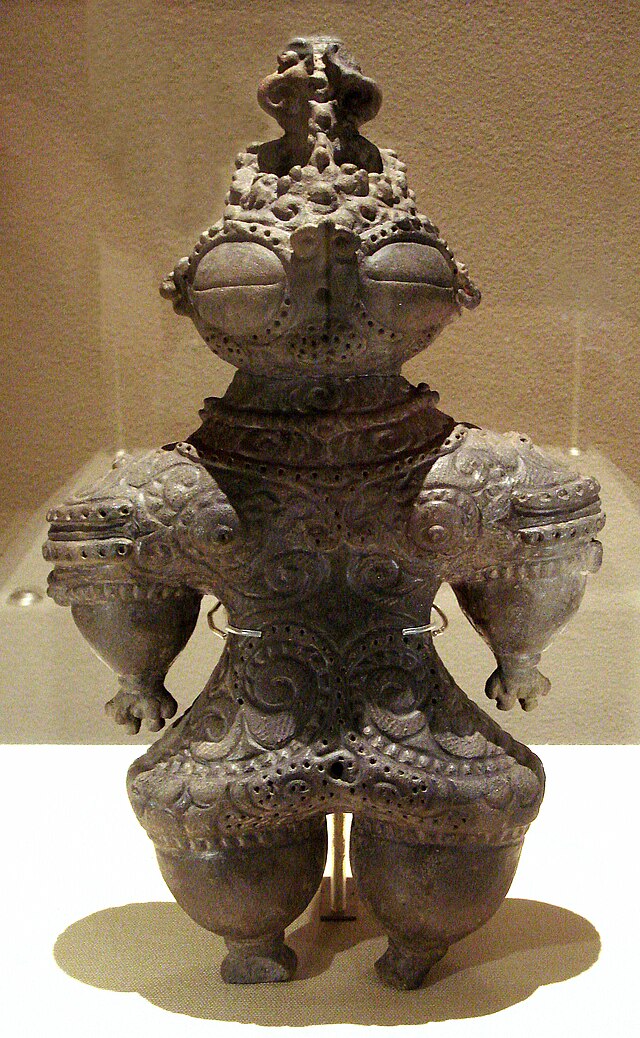Loading AI tools
Type of figurine from prehistoric Japan From Wikipedia, the free encyclopedia
Dogu (Japanese: 土偶, IPA: [doɡɯː]; literally "earthen figure") are small humanoid and animal figurines made during the later part of the Jōmon period (14,000–400 BC) of prehistoric Japan.[a] Dogū come exclusively from the Jōmon period, and were no longer made by the following Yayoi period. There are various styles of dogū, depending on the exhumation area and time period.[1][3]

The National Museum of Japanese History estimates that the total number of dogū is approximately 15,000, with The Japan Times placing the figure at approximately 18,000.[1][3] Dogū were made across all of Japan, except Okinawa. Most of the dogū have been found in eastern Japan and it is rare to find one in western Japan. The purpose of the dogū remains unknown and should not be confused with the clay haniwa funerary objects of the Kofun period (250 – 538 C.E.).[4]
Everyday ceramic items from the period are called Jōmon pottery.
Some scholars theorize the dogū acted as effigies of people, that manifested some kind of sympathetic magic.[5] For example, it may have been believed that illnesses could be transferred into the dogū, which were then destroyed, clearing the illness, or any other misfortune.[6]
Dogū are made of clay and are small, typically 10 to 30 cm high.[4] Most of the figurines appear to be modeled as female, and have big eyes, small waists, and wide hips.[1] They are considered by many to be representative of goddesses. Many have large abdomens associated with pregnancy, suggesting that the Jomon considered them mother goddesses.[4] According to the Metropolitan Museum of Art, these figurines "suggest an association with fertility and shamanistic rites".[7]
The dogū tend to have large faces, small arms and hands and compact bodies. Some appear to wear goggles or have "heart-shaped" faces. Most have marks on the face, chest and shoulders, that suggest tattooing and probable incision with bamboo.[8][9][10]

The Shakōkidogū (遮光器土偶), or "goggle-eyed dogū", were created in the Jōmon era, and are so well known that when most Japanese hear the term dogū, this is the image that comes to mind.[citation needed] The name shakōki (literally "light-blocking device") comes from the resemblance of the figures' eyes to traditional Inuit snow goggles. Another distinguishing feature of the objects are the exaggerated female buttocks, chest and thighs.[12] Furthermore, the abdomen is covered with patterns, many of which seem to have been painted with vermilion. The larger figures are hollow.
Unbroken figures are rare, and most are missing an arm, leg or other body part. In many cases, the parts have been cut off.
These types of dogū have been found in the Kamegaoka Site in Tsugaru, Aomori Prefecture; the Teshiromori Site in Morioka, Iwate Prefecture; the Ebisuda Site in Tajiri, Miyagi Prefecture; and the Izumisawa Kaizuka Site in Ishinomaki, Miyagi Prefecture. All the sites listed have been designated as Important Cultural Properties.
Seamless Wikipedia browsing. On steroids.
Every time you click a link to Wikipedia, Wiktionary or Wikiquote in your browser's search results, it will show the modern Wikiwand interface.
Wikiwand extension is a five stars, simple, with minimum permission required to keep your browsing private, safe and transparent.